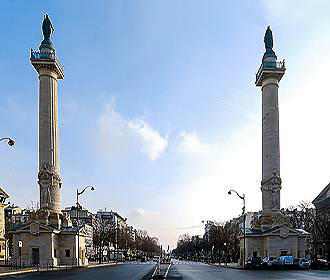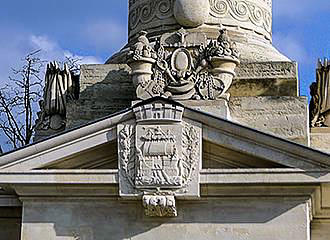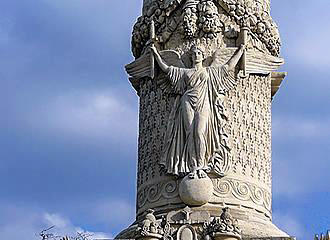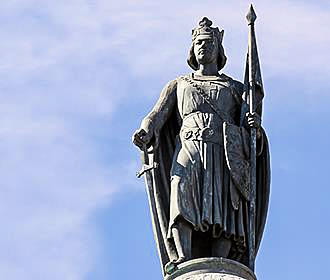Paris Barriere du Trone and the Colonnes du Trone
The Throne Barrier and the two columns were constructed as part of the Wall of the Farmers General back in the 1700s by the Place de la Nation, yet the columns were not adorned with statues until the 1800s, and ironically even though these historical Paris monuments are positioned opposite each other, they are both within different Arrondissements of Paris.
About the Paris Barriere du Trone and the Colonnes du Trone
The historical Paris Barriere du Trone with its columns called Colonnes du Trone, are located right next to a square in Paris called the Place de la Nation, which was originally called Place du Trone, due to the fact that there was once a throne put in place within the square for the arrival of Louis XIV and his new wife Maria Theresa of Spain.
So, when the Wall of the Farmers general was being constructed to form a barrier around the city in order to obtain the octroi, or toll, sometimes referred to as a grant or taxes, which was for goods entering the city, this particular section of the wall and its gates were named after the squares original name, which then got renamed to the Place de la Nation in the 1800s.
Now this wall had customs offices and gates, and all of the buildings were designed by the architect Claude Nicolas Ledoux, and in only around three years there were over fifty constructed, with one of the most famous being the historical building in Paris called La Rotonde de la Villette.
But getting back to the very little known historical Paris monument in Paris called the Barriere du Trone et Les Colonnes du Trone, which translates in English to the Throne Barrier and the Columns of the Throne.
There are actually two pavilions or small buildings located opposite each other, and each one has a tall column, which served as the gate houses for the Wall of the Farmers General. And this was also the entrance into Paris from the Bois de Vincennes, which is why the columns were put in place, but also why the columns are sometimes referred to as the Colonnes de Vincennes.
And as you read earlier, these were designed by the architect Claude Nicolas Ledoux, and were constructed in 1787, with the columns being in stone in a Doric style of classical architecture with a very austere, or plain yet severe appearance, and without any form of decoration like you can see today.
But it was only shortly after the Barriere du Trone and the Colonnes du Trone had been constructed, that the French Revolution started and the tax on goods entering the city was abolished in 1791. This meant that at that time the wall was no longer required, even though the duty was put back in place afterwards, and became more accepted during the reign of Napoleon Bonaparte.
It was then King Louis Philippe that was responsible for adding to the Throne Columns, and there are two bas reliefs on the columns themselves, with one of these, being on the side of the 11th Arrondissement representing Trade and Industry, and the other represents Peace and Victory, which were produced by the artists Antoine Desboeufs and Pierre-Charles Simart.
In addition to these, there were two bronze statues added to the top of the Colonnes du Trone in 1843, which weigh in at approximately 2.5 tons each, and the one located in the 12th Arrondissement was designed to represent Philippe Augustus, which was sculpted by the artist Antoine Etex, whereas the other bronze statue represents Saint Louis, and this was produced by the sculptor Alexandre Dumont.
Paris Barriere du Trone and the Colonnes du Trone 1800s
Then in the 1850s and 1860s under the guidance of Baron Haussmann, the city of Paris was being completely redesigned with new roads, buildings, etc and in the year 1860, the tax or duty on goods coming from the water or earth entering the city was abolished. So, much of the Wall of the Farmers General was completely destroyed and there are only a few parts remaining today, which have all been classified as historical Paris monuments.
And although this is a very little known monument, it played a major role within the history of Paris, which led to the Paris Barriere du Trone being saved from destruction along with the Colonnes du Trone, which, by the way, are also sometimes referred to as Les Colonnes du Barriere du Trone.
However, over time these have seen much wear and tear, having been subjected to world wars, the Nazi occupation of Paris, and of course environmental factors have also attributed to their need for major restoration, which took place over a period of two years starting in September 2008.
So today you can enjoy the two bronze statues that were fully restored, one being a statue of Philippe Augustus that was put back on the top of the column on the 5th May 2010 and the other statue of Saint Louis being put back on the 19th May 2010, making these a magnificent tourist attraction once more.
Visiting Paris Barriere du Trone and the Colonnes du Trone
Now as we mentioned earlier, the Paris Barriere du Trone and the Colonnes du Trone are located opposite each other, but one is in the 11th Arrondissement and the other is located in the 12th Arrondissement, and these are situated in between the Place de la Nation and the Cours de Vincennes.
So when it comes to Paris public transport, you will find that there is a Metro station called the Nation stop, which serves lines 1, 2, 6 and 9, which is also a train station serving line A of the RER trains.
However, in the opposite direction to Les Colonnes du Barriere du Trone, you have the Porte de Vincennes Metro stop serving line 1, which is also a Tramway stop serving the Tram lines T3a and T3b.
The Paris bus lines 26, 56, 57, 64, 86 and 351 along with the Noctilien Night Bus Service via Line N11, will also get you reasonably close by and within walking distance of this historical monument.



